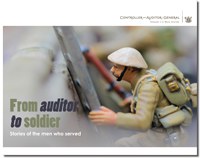Charles Jeremiah Marsh Gair
 Charles Jeremiah Marsh Gair was born in Cromwell, Central Otago, in December 1892. He joined the Audit Department in January 1910. By the outbreak of WW1, Charles had attained the position of Audit Examiner, Class VII.
Charles Jeremiah Marsh Gair was born in Cromwell, Central Otago, in December 1892. He joined the Audit Department in January 1910. By the outbreak of WW1, Charles had attained the position of Audit Examiner, Class VII.
In August 1914, Charles, aged 21, joined the New Zealand Expeditionary Force. He was appointed to the New Zealand Rifle Brigade with the rank of Sergeant and deployed to Samoa from August 1914 to April 1915, as part of the Samoan Advance Party.
On his return to New Zealand, Charles spent several months at the Trentham Military Camp, where he gave evidence to a Commission of Inquiry into the cramped, cold, and unhygienic conditions at the camp.
In October 1915, Charles was posted overseas again, first to Egypt and then to France. He served with the 1st Battalion of the New Zealand Rifle Brigade on the Western Front.
In September 1916, Charles took part in the Battle of the Somme. On 15 September 1916, all the Allied forces were to advance in a co-ordinated attack. The New Zealand Division, comprising the Otago and Auckland Battalions and the Rifle Brigade, was to attack on a 1000-yard front. The Division suffered heavy casualties but captured several trenches and, led by the Rifle Brigade, captured the final objective for the first day – the village of Flers and high ground to the north.
In describing the military action that took place on 15 September, W S Austin’s Official History of the New Zealand Rifle Brigade refers to Charles as follows:
Company-Sergt.-Major G. H. Boles early in the afternoon found himself in command of his company, now without an officer, and both in Grove Alley as well as later in the line of posts north-east of Flers, displayed remarkable powers of leadership and organization. Here also Sergeants A. R. Blackmore, R. T. Caldwell and C. Gair proved their ability in grappling with unusual situations, and their independent work was of the utmost value during the establishment and final consolidation of the line covering Flers.
On 8 December 1916, Charles was awarded the Distinguished Conduct Medal (DCM) for:
... conspicuous gallantry and devotion to duty. He has performed consistent good work throughout, and has at all times set a splendid example.
In February 1917, Charles transferred to the Officer Training Corps. In June 1917, he was promoted to 2nd Lieutenant.
In September 1917, Charles was “seconded for duty in New Zealand”. He returned to New Zealand and was based at Featherston Military Camp, then the largest training camp in New Zealand. He was an Army physical training instructor.
Charles stayed in New Zealand. On 20 April 1918, he was married, at St James’ Church in Wellington, to Emma Lorna Greenwood of Otago.
In January 1919, Charles was discharged from the New Zealand Expeditionary Force. As well as the DCM, he was awarded the 1914-15 Star, the British War Medal, and the Victory Medal.
Charles resumed work with the Audit Department. He was appointed to a senior position – Audit Inspector, Wellington, Class V. He still found time to be a Wellington rugby representative in 1919, 1921, and 1922. In 1919, his Wellington team won the Ranfurly Shield from Canterbury.
Charles’ name appears as the auditor in several Court cases that were reported in the newspapers. In February 1922, a report covered the case of a manager at the State firewood depot in Wellington who was accused of stealing money. The report said that:
Charles Gair, audit inspector, said on January 18, while auditing the books of the City Council, he discovered a voucher for firewood supplied by the Government firewood depot. The voucher had been receipted but no official receipt was attached.
The report went on to describe how Charles carried out investigations at the firewood depot and found that the cheque paid by the City Council had not been entered in the cash book. Other examples were found of cheques not being entered. The manager pleaded guilty.
In September 1926, another newspaper reported a case of theft by the Town Clerk of Brunner. The report said that:
The principal witness was Charles Gair, who travels the West Coast as Government audit inspector, and he told how the town clerk had been accepting money in payment of rates, but failed to bank the amounts.
The Town Clerk pleaded guilty.
Charles later held the position of Audit Inspector, Napier, Audit Inspector for Western Samoa (for four and a half years), and Audit Inspector, Christchurch.
A former staff member recalls:
A couple of years ago, I worked on a history of auditing in Samoa. In 1933, the auditor of the Post Office Savings Bank in Samoa was Charles Gair. He was investigating a case of possible theft and wrote, on a confidential basis, to the Auditor-General in Wellington asking for some information. Instead of getting back to Gair, the Auditor-General got in touch with the Post Office’s head office in Wellington. The local post master approached Gair in the street in Apia and told him there was no basis to his concerns. Gair was furious and wrote two angry letters to the Auditor-General, telling him off. I remember wondering who on earth this Gair chap was to write to the Auditor-General in such terms. I now know that he served with distinction on the Western Front and telling off the Auditor-General would not have troubled him in the least.
In May 1951, Charles, then the Deputy Controller and Auditor-General and Supervisor, Local Body Audits, retired from the Audit Department. He taught his grandchildren chess and stamp collecting, and had a great love of cricket. He was also a skilled gardener.
Charles died on 8 December 1964.

